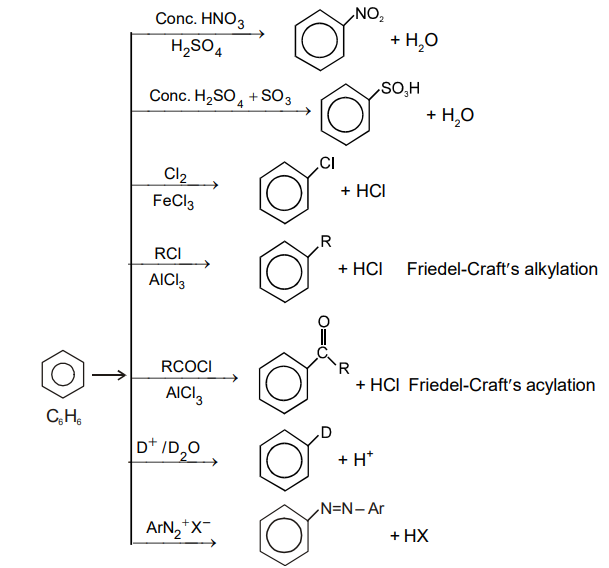Aromatic Compounds
Points to remember in Aromatic Compounds
Electrophilic aromatic substitution:
PYQ-2024-Haloalkanes_and_Haloarenes-Q13, PYQ-2024-Haloalkanes_and_Haloarenes-Q3
(a) Bromination of Benzene:
Bromination follows the general mechanism for electrophilic aromatic substitution. Bromine itself is not sufficiently electrophilic to react with benzene, but a strong Lewis acid such as $FeBr_3$ catalyzes the reaction.
Step 1 : Formation of a stronger electrophile.
Step 2 : Electrophilic attack and formation of the sigma complex.

Step 3 : Loss of a proton gives the products.
(b) Nitration:
PYQ-2024-Hydrocarbons-Q19, PYQ-2024-Hydrocarbons-Q20, PYQ-2024-Biomolecules-Q11
(c) Sulphonation:
The electrophilic reagent $\mathrm{SO}_{3}$, attacks the benzene ring to form the intermediate carbocation.
$
2 H_2 SO_4 \rightleftharpoons SO_3 + H_3 O^{\oplus} + HSO_4^{\ominus}
$
(d) Friedel-Crafts reaction:
PYQ-2024-Hydrocarbons-Q14, PYQ-2024-Hydrocarbons-Q2, PYQ-2024-Carboxylic_Acid_and_Derrivaties-Q1
Alkylation mechanism :
Acylation mechanism:
Acylation of benzene may be brought about with acid chlorides or anhydrides in presence of lewis acids.
Step 1 : Formation of an acylium ion.

Step 2 : Electrophilic attack.

Step 3 : Loss of a proton.
Chemical Reactions of Benzene:

Nucleophilic Aromatic Substitution Reaction
PYQ-2024-Haloalkanes_and_Haloarenes-Q10
Rate of Electrophilic and Nucleophilic Attack
-
Electrophilic attack will be faster at positions such that the carbocations produced have positive charges on carbons which are bonded to electron donating groups like methy groups. This occurs when attack happens at positions ortho and para to the electron donating group.
-
The stability of carbocation will determine the speed of the rate of reaction (more the stability faster the reaction). Therefore the more easily the leaving group (X–) can leave the compound the more easily the nucleophile can attack the compound and leads to substitution process.






